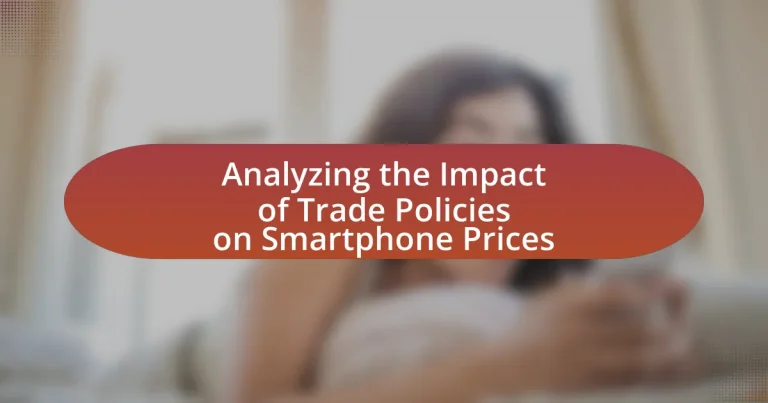The article analyzes the impact of trade policies on smartphone prices, highlighting how regulations and agreements governing international trade, such as tariffs and import quotas, directly affect the cost of smartphones for consumers. It discusses the significant influence of trade policies on the global smartphone market, including how tariffs can lead to increased retail prices and reduced consumer demand. Additionally, the article examines specific trade policies that affect smartphone imports and exports, the role of supply chains, and the implications for consumer choices and purchasing power. It also explores future trends in trade policies and their potential effects on smartphone affordability and pricing strategies among manufacturers.

What are Trade Policies and Their Relevance to Smartphone Prices?
Trade policies are regulations and agreements that govern international trade, impacting tariffs, import quotas, and trade agreements. These policies are relevant to smartphone prices because they directly influence the cost of importing components and finished devices. For instance, high tariffs on imported smartphones can lead to increased retail prices for consumers, as manufacturers often pass these costs onto buyers. According to a 2021 report by the International Trade Administration, a 25% tariff on smartphones could raise prices by approximately 10% to 15%, demonstrating the significant impact of trade policies on market pricing.
How do trade policies influence the global smartphone market?
Trade policies significantly influence the global smartphone market by affecting tariffs, import/export regulations, and market access. For instance, high tariffs on imported smartphones can increase retail prices, thereby reducing consumer demand and impacting sales volumes. According to a report by the International Trade Administration, tariffs imposed by the United States on Chinese smartphones led to a price increase of approximately 20% for certain models, which directly affected purchasing decisions. Additionally, trade agreements can facilitate smoother market entry for manufacturers, enhancing competition and innovation. The North American Free Trade Agreement (NAFTA) allowed for tariff-free trade among the U.S., Canada, and Mexico, which contributed to the growth of smartphone production and sales in North America. Thus, trade policies shape pricing strategies, market dynamics, and ultimately consumer access to smartphones globally.
What specific trade policies affect smartphone imports and exports?
Specific trade policies that affect smartphone imports and exports include tariffs, import quotas, and trade agreements. Tariffs, such as those imposed by the United States on Chinese-made smartphones, increase the cost of imports, thereby influencing retail prices and market competitiveness. Import quotas limit the quantity of smartphones that can be imported, affecting supply and potentially driving up prices. Trade agreements, like the United States-Mexico-Canada Agreement (USMCA), can facilitate smoother trade flows and reduce tariffs, impacting the overall pricing structure of smartphones in participating countries. These policies directly shape the economic landscape for smartphone manufacturers and consumers alike.
How do tariffs impact the pricing of smartphones?
Tariffs increase the pricing of smartphones by adding additional costs to imported devices. When tariffs are imposed on smartphones, manufacturers and retailers often pass these costs onto consumers, resulting in higher retail prices. For example, a 25% tariff on smartphones can lead to an equivalent increase in prices, as seen in the U.S.-China trade tensions where tariffs on electronics significantly affected market prices. This relationship between tariffs and smartphone pricing is evident in economic studies that show a direct correlation between tariff rates and consumer prices in the electronics sector.
Why are smartphone prices sensitive to trade policy changes?
Smartphone prices are sensitive to trade policy changes because tariffs and import regulations directly affect production costs and market pricing. When trade policies impose tariffs on imported components or finished smartphones, manufacturers often pass these increased costs onto consumers, leading to higher retail prices. For instance, the U.S.-China trade war resulted in tariffs on various electronics, including smartphones, which caused price increases of up to 20% for certain models. Additionally, changes in trade agreements can alter supply chain dynamics, impacting availability and competition, further influencing pricing strategies in the smartphone market.
What role do supply chains play in smartphone pricing?
Supply chains significantly influence smartphone pricing by determining production costs, delivery times, and overall efficiency. The complexity of global supply chains, which involve multiple suppliers and manufacturers across different countries, affects the cost of raw materials, labor, and logistics. For instance, disruptions in supply chains, such as those caused by trade policies or geopolitical tensions, can lead to increased costs that are often passed on to consumers. According to a report by the International Trade Centre, tariffs and trade barriers can raise the cost of imported components, directly impacting the final retail price of smartphones.
How do currency fluctuations relate to trade policies and smartphone costs?
Currency fluctuations significantly impact trade policies and smartphone costs by altering the relative prices of imported and exported goods. When a country’s currency depreciates, the cost of importing smartphones increases, leading manufacturers to raise retail prices to maintain profit margins. For instance, a 10% depreciation of the euro against the dollar can increase the cost of U.S. smartphones in Europe, prompting companies to adjust their pricing strategies. Additionally, trade policies, such as tariffs, can exacerbate these effects; for example, a tariff on imported smartphones can further inflate prices, compounding the impact of currency fluctuations. Thus, the interplay between currency values and trade regulations directly influences smartphone pricing in global markets.

What are the Effects of Trade Policies on Smartphone Pricing Strategies?
Trade policies significantly influence smartphone pricing strategies by affecting import tariffs, trade agreements, and regulatory standards. For instance, high import tariffs can increase the cost of components and finished smartphones, leading manufacturers to raise retail prices to maintain profit margins. Conversely, favorable trade agreements can lower tariffs, allowing companies to reduce prices or invest in innovation. A specific example is the U.S.-China trade tensions, where tariffs on Chinese-made smartphones resulted in increased prices for consumers in the U.S. This demonstrates that trade policies directly impact the cost structure and pricing strategies of smartphone manufacturers.
How do manufacturers adjust pricing in response to trade policies?
Manufacturers adjust pricing in response to trade policies by altering their product prices to reflect changes in tariffs, import duties, and regulations. For instance, when a government imposes higher tariffs on imported components, manufacturers may increase the prices of their smartphones to maintain profit margins. According to a study by the Peterson Institute for International Economics, a 25% tariff on imported goods can lead to a price increase of approximately 10% for consumers. This adjustment helps manufacturers offset increased costs and remain competitive in the market.
What pricing strategies are commonly used by smartphone companies?
Smartphone companies commonly use several pricing strategies, including penetration pricing, skimming pricing, and competitive pricing. Penetration pricing involves setting a low initial price to attract customers and gain market share quickly, as seen with brands like Xiaomi, which often enter markets with lower prices to disrupt competitors. Skimming pricing, on the other hand, sets high initial prices for new or innovative products to maximize profits from early adopters, a strategy frequently employed by Apple during the launch of new iPhone models. Competitive pricing aligns a company’s prices with those of its competitors to maintain market position, which is evident in how Samsung prices its Galaxy series in relation to other flagship smartphones. These strategies are influenced by trade policies, market demand, and competitive dynamics, affecting overall pricing structures in the smartphone industry.
How do trade policies affect competitive pricing among brands?
Trade policies significantly influence competitive pricing among brands by altering the cost structure of imported goods. For instance, tariffs imposed on imported smartphones increase the overall cost for brands that rely on foreign manufacturing, leading them to raise retail prices to maintain profit margins. According to a study by the Peterson Institute for International Economics, a 25% tariff on smartphones could raise prices by approximately 10% in the U.S. market. This price increase affects competition, as domestic brands may benefit from reduced competition while foreign brands struggle to maintain market share. Thus, trade policies directly impact pricing strategies and competitive dynamics among smartphone brands.
What are the implications of trade policies for consumers?
Trade policies significantly affect consumers by influencing the prices and availability of goods, including smartphones. For instance, tariffs imposed on imported smartphones can lead to higher retail prices, as manufacturers often pass these costs onto consumers. According to a study by the Consumer Technology Association, a 25% tariff on smartphones could increase prices by approximately $100 per device. Additionally, trade policies can impact the variety of products available in the market; restrictive policies may limit consumer choices, while favorable trade agreements can enhance access to a broader range of smartphones. Thus, trade policies directly shape consumer experiences through pricing and product availability.
How do trade policies influence consumer choices and purchasing power?
Trade policies significantly influence consumer choices and purchasing power by affecting the prices and availability of goods. For instance, tariffs imposed on imported smartphones can lead to higher retail prices, reducing consumers’ purchasing power as they may have to spend more for the same product. According to a study by the Peterson Institute for International Economics, a 25% tariff on smartphones could increase prices by approximately 20%, directly impacting consumer decisions and limiting their options. Additionally, trade agreements that lower tariffs can enhance competition and lead to lower prices, thereby increasing consumer purchasing power and expanding choices in the market.
What are the potential long-term effects on smartphone affordability?
The potential long-term effects on smartphone affordability include increased prices due to tariffs and trade restrictions, which can limit competition and raise production costs. For instance, the imposition of tariffs on imported components can lead manufacturers to pass these costs onto consumers, resulting in higher retail prices. Additionally, trade policies that favor domestic production may reduce the availability of cheaper foreign alternatives, further constraining affordability. Historical data shows that during periods of heightened trade tensions, such as the U.S.-China trade war, smartphone prices rose significantly, illustrating the direct impact of trade policies on consumer costs.

What are the Future Trends in Trade Policies and Smartphone Prices?
Future trends in trade policies are likely to focus on increased protectionism and regional trade agreements, which will impact smartphone prices by potentially raising costs due to tariffs and trade barriers. For instance, the U.S.-China trade tensions have already led to tariffs on various electronics, including smartphones, resulting in higher retail prices. Additionally, as countries prioritize local manufacturing to reduce dependency on imports, the cost of production may rise, further influencing smartphone pricing. Historical data shows that trade policies directly correlate with price fluctuations; for example, a 25% tariff on Chinese imports in 2019 led to an average price increase of 10% for affected smartphone models.
How might upcoming trade agreements impact smartphone pricing?
Upcoming trade agreements may lower smartphone pricing by reducing tariffs and trade barriers. For instance, the United States-Mexico-Canada Agreement (USMCA) has provisions that eliminate tariffs on certain electronic goods, which can lead to cost savings for manufacturers. These savings can be passed on to consumers, resulting in lower retail prices. Additionally, trade agreements often encourage competition by allowing foreign manufacturers easier access to domestic markets, which can further drive down prices. Historical data shows that when tariffs on electronics were reduced in previous trade agreements, prices for consumers decreased significantly, demonstrating a clear correlation between trade policies and smartphone pricing.
What trends are emerging in global trade that could affect smartphone costs?
Emerging trends in global trade that could affect smartphone costs include increasing protectionism, shifts in supply chain dynamics, and the rise of regional trade agreements. Protectionist measures, such as tariffs imposed by countries like the United States on Chinese imports, directly increase manufacturing costs for smartphones, leading to higher retail prices. Additionally, companies are diversifying their supply chains to mitigate risks associated with geopolitical tensions, which can result in increased production costs as manufacturers relocate to countries with higher labor costs. Furthermore, regional trade agreements, such as the Comprehensive and Progressive Agreement for Trans-Pacific Partnership (CPTPP), can lower tariffs among member countries, potentially reducing costs for smartphones produced within those regions. These trends collectively influence the pricing structure of smartphones in the global market.
How do geopolitical factors influence future trade policies related to smartphones?
Geopolitical factors significantly influence future trade policies related to smartphones by shaping regulations, tariffs, and international relations among countries. For instance, tensions between the United States and China have led to increased tariffs on smartphone imports, affecting pricing and market access for companies like Apple and Huawei. Additionally, geopolitical alliances, such as trade agreements or sanctions, can dictate which countries are favored for trade, impacting supply chains and production costs. Historical events, such as the U.S.-China trade war, illustrate how political decisions directly alter trade dynamics, resulting in fluctuating smartphone prices and availability in various markets.
What can consumers do to navigate changes in smartphone pricing due to trade policies?
Consumers can navigate changes in smartphone pricing due to trade policies by researching and comparing prices across different retailers and brands. This approach allows consumers to identify the best deals and understand how trade policies may affect pricing strategies. For instance, when tariffs are imposed on imported smartphones, prices may increase, prompting consumers to seek alternatives or wait for sales. Additionally, consumers can consider purchasing older models or refurbished devices, which often remain unaffected by new trade policies and can offer significant savings. By staying informed about trade policy developments and their implications on pricing, consumers can make more strategic purchasing decisions.
What strategies can consumers employ to find the best smartphone deals?
Consumers can employ several strategies to find the best smartphone deals, including comparing prices across multiple retailers, utilizing price tracking tools, and taking advantage of seasonal sales. By comparing prices on websites like PriceGrabber or Google Shopping, consumers can identify the lowest available prices for specific smartphone models. Price tracking tools, such as CamelCamelCamel for Amazon, alert consumers when prices drop, ensuring they purchase at the optimal time. Additionally, major sales events like Black Friday or back-to-school promotions often feature significant discounts on smartphones, making these periods ideal for purchasing. These strategies are effective as they leverage market competition and consumer demand trends, ultimately leading to better pricing outcomes.
How can consumers stay informed about trade policy changes affecting smartphone prices?
Consumers can stay informed about trade policy changes affecting smartphone prices by regularly following reputable news sources, government announcements, and industry reports. Major news outlets often cover significant trade policy developments, while government websites provide official updates on tariffs and regulations. Additionally, industry analysts and market research firms publish reports that analyze the implications of trade policies on consumer electronics pricing. For instance, the U.S. Trade Representative’s website frequently updates information on tariffs that directly impact smartphone costs, allowing consumers to understand how these changes may affect their purchases.




